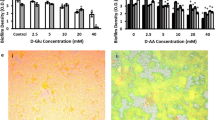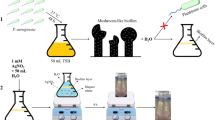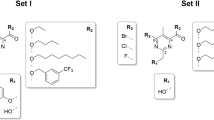Abstract
This study aims to investigate the antibacterial and anti-biofilm activities of YycG inhibitors H2-60 and H2-81 against Streptococcus agalactiae. A total of 118 nonduplicate S. agalactiae clinical isolates were collected, and the minimal inhibitory concentrations (MICs) of H2-60 and H2-81 were determined. H2-60 and H2-81 inhibit biofilm formation of S. agalactiae were detected by crystal violet staining, and against established biofilms of S. agalactiae were observed by confocal laser scanning microscope. Inhibitory effect of H2-60 and H2-81 on the phosphorylation activity of the HisKA domain of YycG’ protein was measured. The MIC50/MIC90 was 3.13/6.25 μM for H2-60 and 6.25/12.5 μM for H2-81 against S. agalactiae, respectively. S. agalactiae planktonic cells can be decreased by H2-60 or H2-81 for more than 3 × log10 CFU ml−1 after 24 h treatment. Biofilm formation of 8 S. agalactiae strains (strong biofilm producers) was significantly reduced after treated with 1/4 × MIC of H2-60 or H2-81 for 24 h. H2-60 and H2-81 could reduce 45.79% and 29.56% of the adherent cells in the established biofilm of S. agalactiae after 72 h treatment, respectively. H2-60 combined with daptomycin reduced 83.63% of the adherent cells in the established biofilm of S. agalactiae, which was significantly better than that of H2-60 (45.79%) or daptomycin (55.07%) alone. The half maximal inhibitory concentrations (IC50) were 35.6 μM for H2-60 and 46.3 μM for H2-81 against the HisKA domain of YycG’ protein. In conclusion, YycG inhibitors H2-60 and H2-81 exhibit excellent antibacterial and anti-biofilm activities against S. agalactiae.
This is a preview of subscription content, access via your institution
Access options
Subscribe to this journal
Receive 12 print issues and online access
$259.00 per year
only $21.58 per issue
Buy this article
- Purchase on Springer Link
- Instant access to full article PDF
Prices may be subject to local taxes which are calculated during checkout





Similar content being viewed by others
References
Furfaro LL, Chang BJ, Payne MS. Perinatal Streptococcus agalactiae Epidemiology and Surveillance Targets. Clin Microbiol Rev. 2018;31:e00049–18.
Raabe VN, Shane AL. Group B Streptococcus (Streptococcus agalactiae). Microbiol Spectr. 2019;7: https://doi.org/10.1128/microbiolspec.GPP3-0007-2018.
Longtin J, Vermeiren C, Shahinas D, Tamber GS, McGeer A, Low DE, et al. Novel mutations in a patient isolate of Streptococcus agalactiae with reduced penicillin susceptibility emerging after long-term oral suppressive therapy. Antimicrob Agents Chemother. 2011;55:2983–5.
Kimura K, Matsubara K, Yamamoto G, Shibayama K, Arakawa Y. Active screening of group B streptococci with reduced penicillin susceptibility and altered serotype distribution isolated from pregnant women in Kobe, Japan. Jpn J Infect Dis. 2013;66:158–60.
Wang P, Tong JJ, Ma XH, Song FL, Fan L, Guo CM, et al. Serotypes, antibiotic susceptibilities, and multi-locus sequence type profiles of Streptococcus agalactiae isolates circulating in Beijing, China. PLoS ONE. 2015;10:e0120035.
Wang YH, Chen CL, Hou JN, Wang YR, Lin TY, Wang MH, et al. Serotype distribution and resistance genes associated with macrolide and fluoroquinolone resistance in Streptococcus agalactiae isolates from a hospital in southern Taiwan. Biomed J. 2015;38:215–20.
Piccinelli G, Biscaro V, Gargiulo F, Caruso A, De, Francesco MA. Characterization and antibiotic susceptibility of Streptococcus agalactiae isolates causing urinary tract infections. Infect Genet Evol. 2015;34:1–6.
Rosini R, Margarit I. Biofilm formation by Streptococcus agalactiae: influence of environmental conditions and implicated virulence factors. Front Cell Infect Microbiol. 2015;5:6.
Wang Y, Wang Y, Sun L, Grenier D, Yi L. Streptococcus suis biofilm: regulation, drug-resistance mechanisms, and disinfection strategies. Appl Microbiol Biotechnol. 2018;102:9121–9.
Gonzalez Moreno M, Trampuz A, Di Luca M. Synergistic antibiotic activity against planktonic and biofilm-embedded Streptococcus agalactiae, Streptococcus pyogenes and Streptococcus oralis. J Antimicrob Chemother. 2017;72:3085–92.
Shan Y, Yang N, Teng D, Wang X, Mao R, Hao Y, et al. Recombinant of the Staphylococcal Bacteriophage Lysin CHAPk and Its Elimination against Streptococcus agalactiae Biofilms. Microorganisms. 2020;8:216.
Prüß BM. Involvement of Two-Component Signaling on Bacterial Motility and Biofilm Development. J Bacteriol. 2017;199:e00259–17.
Bem AE, Velikova N, Pellicer MT, Baarlen PV, Marina A, Wells JM. Bacterial histidine kinases as novel antibacterial drug targets. ACS Chem Biol. 2015;10:213–24.
Fabret C, Hoch JA. A two-component signal transduction system essential for growth of Bacillus subtilis: implications for anti-infective therapy. J Bacteriol. 1998;180:6375–83.
Martin PK, Li T, Sun D, Biek DP, Schmid MB. Role in cell permeability of an essential two-component system in Staphylococcus aureus. J Bacteriol. 1999;181:3666–73.
Qin Z, Zhang J, Xu B, Chen L, Wu Y, Yang X, et al. Structure-based discovery of inhibitors of the YycG histidine kinase: new chemical leads to combat Staphylococcus epidermidis infections. BMC Microbiol. 2006;6:96.
Stipp RN, Boisvert H, Smith DJ, Höfling JF, Duncan MJ, Mattos-Graner RO. CovR and VicRK regulate cell surface biogenesis genes required for biofilm formation in Streptococcus mutans. PLoS ONE. 2013;8:e58271.
Mohedano ML, Overweg K, de la Fuente A, Reuter M, Altabe S, Mulholland F, et al. Evidence that the essential response regulator YycF in Streptococcus pneumoniae modulates expression of fatty acid biosynthesis genes and alters membrane composition. J Bacteriol. 2005;187:2357–67.
Liu H, Zhao D, Chang J, Yan L, Zhao F, Wu Y, et al. Efficacy of novel antibacterial compounds targeting histidine kinase YycG protein. Appl Microbiol Biotechnol. 2014;98:6003–13.
Zheng JX, Wu Y, Lin ZW, Pu ZY, Yao WM, Chen Z, et al. Characteristics of and Virulence Factors Associated with Biofilm Formation in Clinical Enterococcus faecalis Isolates in China. Front Microbiol. 2017;8:2338.
Liu H, Zhao Y, Zhao D, Gong T, Wu Y, Han H, et al. Antibacterial and anti-biofilm activities of thiazolidione derivatives against clinical staphylococcus strains. Emerg Microbes Infect. 2015;4:e1.
Heidary M, Khosravi AD, Khoshnood S, Nasiri MJ, Soleimani S, Goudarzi M. Daptomycin. J Antimicrob Chemother. 2018;73:1–11.
Moormeier DE, Bayles KW. Staphylococcus aureus biofilm: a complex developmental organism. Mol Microbiol. 2017;104:365–76.
Wu H, Moser C, Wang HZ, Høiby N, Song ZJ. Strategies for combating bacterial biofilm infections. Int J Oral Sci. 2015;7:1–7.
Verderosa AD, Totsika M, Fairfull-Smith KE. Bacterial Biofilm Eradication Agents: a current review. Front Chem. 2019;7:824.
Acknowledgements
The authors thank Prof Di Qu and Yang Wu (Key Laboratory of Medical Molecular Virology of Ministries of Education and Health, School of Basic Medical Science and Institutes of Biomedical Sciences, Shanghai Medical College of Fudan University) for their suggestions and guidance. The authors also thank Dr Weiguang Pan and Jie Lian (Department of Laboratory Medicine, Huazhong University of Science and Technology Union Shenzhen Hospital), Dr Ying Wei (Department of Microbiology, the fourth Affiliated Hospital of Harbin Medical University) for helping identify and preserve the S. agalactiae strains.
Author information
Authors and Affiliations
Contributions
XD participated in the design of this study, collected S. agalactiae strains, biofilm assay, and drafted the paper. CZ participated in the collection of S. agalactiae strains, carried out MIC test. JC conducted time-killing assay and participated in the expression of YycG’ protein. YS and XM participated in the collection of S. agalactiae strains, MIC test and biofilm assay. YW and ZW conducted MIC test, biofilm assay and CLSM detection. ZY participated in the data analyze, and reviewed this paper. JZ and ZC designed the study, participated in the expression of YycG’ protein and conducted the inhibition of kinase activity test, conducted the data analysis, and provided critical revisions of the paper for valuable intellectual content.
Funding
This work was supported by the following grants: Sanming Project of Medicine in Shenzhen (No. SMGC201705029); Shenzhen Key Medical Discipline Construction Fund (No. SZXK06162); Natural Science Foundation of Guangdong Province, China (No. 2020A1515111146); Science, Technology and Innovation Commission of Shenzhen Municipality of key funds (JCYJ20180508162403996) and basic research funds (JCYJ20180302144345028; JCYJ20190809151817062); Shenzhen health system research project—discipline construction capacity promotion project (No. SZXJ2018027); Shenzhen Nanshan District Health Science and Technology Fund (No. 2019005).
Corresponding authors
Ethics declarations
Conflict of interest
The authors declare no competing interests.
Ethical approval
All procedures involving human subjects were approved by the institutional ethical committee of Huazhong University of Science and Technology Union Shenzhen Hospital and the fourth Affiliated Hospital of Harbin Medical University. Isolates were collected as part of the routine clinical management of patients, according to the national guidelines in China. Therefore, informed consent was not sought.
Additional information
Publisher’s note Springer Nature remains neutral with regard to jurisdictional claims in published maps and institutional affiliations.
Supplementary information
Rights and permissions
About this article
Cite this article
Deng, X., Zhang, C., Chen, J. et al. Antibacterial and anti-biofilm activities of histidine kinase YycG inhibitors against Streptococcus agalactiae. J Antibiot 74, 874–883 (2021). https://doi.org/10.1038/s41429-021-00475-6
Received:
Revised:
Accepted:
Published:
Issue Date:
DOI: https://doi.org/10.1038/s41429-021-00475-6



